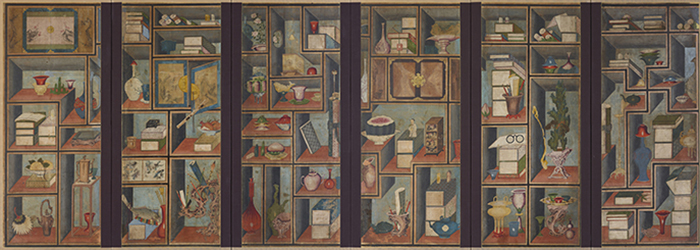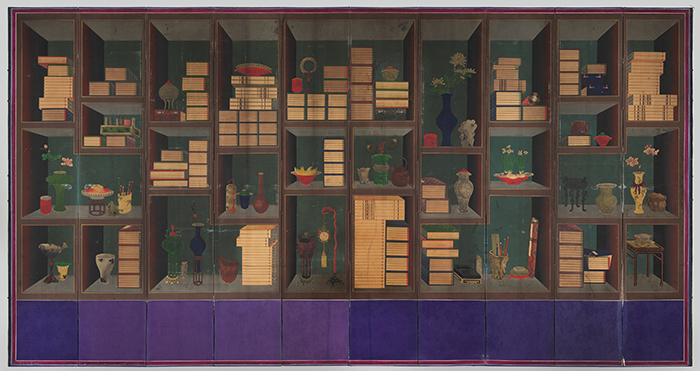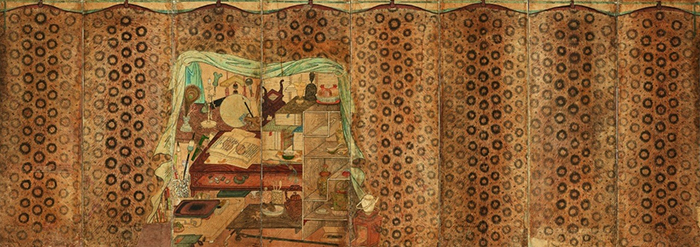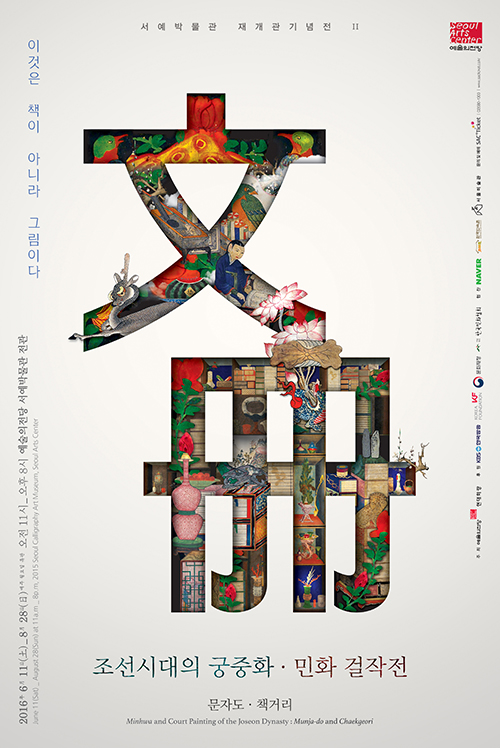
A folding screen of chaekgado, a style of painting that emerged during the reign of King Jeongjo in the late Joseon period, depicts shelves stacked with books, pottery and curious objects.
In 1791, King Jeongjo (1752-1800), the 22nd monarch of the Joseon Dynasty (1392-1910), had a folding screen painted with a chaekgado (책가도, 冊架圖), placed behind his throne. The chaekgado depicted a scholar’s books and belongings, such as pottery and writing tools placed on bookshelves. This eight-panel chaekgado folding screen is believed to embody King Jeongjo's ruling ideology, which was to govern the nation with books and knowledge. With the monarch’s emphasis on studious learning, the chaekgado style of painting trickled down from the royal court to the lower classes and became highly sought after.
On June 11, the Seoul Arts Center in southern Seoul played host to a special exhibition, titled “Minhwa and Court Paintings of The Joseon Dynasty: Munjado and Chaekgeori,” bringing to light a set of Joseon chaekgado works.
Two different terms are used for these paintings. Chaekgado refers to paintings that feature bookshelves, while chaekgeori, as found in the title of the exhibition, is used to refer to paintings that only portray books and other items without the shelves. However, when referring to both forms of painting collectively they are called chaekgeori.
Chaekgeori were divided into royal court paintings and folk paintings, or minhwa. The court paintings were used in ritual ceremonies or as decoration, while the folk paintings were used for the sole purpose of decorating people's homes.

Joseon-era painter Yi Hyeong-rok was well-known for portraying a variety of items, such as books, earthenware and flowers, on his chaekgado folding screens.

One unusual late-Joseon chaekgado depicts a scholar’s study seen through a leopard-print curtain.
Among the exhibits on display at the exhibition are early chaekgado painted during the rule of King Jeongjo, with one by court painter Yi Hyeong-rok (1808-?), and one by court painter Jang Han-jong (1768-1815), which is regarded as one of the greatest chaekgado of late Joseon period. There is also a chaekgado that depicts a scholar’s study partially screened off by a leopard-print curtain.
On display along with these chaekgado is a series of more than 20 folding screens of ideographs, known as munjado (문자도, 文字圖), which depict the eight foundational concepts of Confucianism -- filial piety, fraternal devotion, loyalty, trust, courtesy, commitment, integrity and humility (효제충신예의염치, 孝悌忠信禮義廉恥) -- with calligraphic signs and symbols.
This genre of painting emerged in the late Joseon period and portrays the Chinese characters for the eight foundational concepts of Confucianism on an eight-panel folding screen. It is interesting to note that there are slight variations in munjado from different regions of Korea, with examples from Gangwon-do Province and Jeju Island reflecting very different styles.

A folding screen of painted ideographs, known as munjado, depicts the characters that symbolize the eight cardinal principles of Confucian morality.
The exhibition continues in Seoul until Aug. 28 and then moves to the U.S. for a yearlong tour. The tour will begin at Stony Brook University in New York from September to December, then go on display at Kansas University from March to May next year and finally move to Cleveland Museum of Art for visitors to enjoy from July to September.

The Minhwa and Court Painting of the Joseon Dynasty exhibition continues until Aug. 28 at the Seoul Arts Center.
By Sohn JiAe
Korea.net Staff Writer
Photos: Seoul Arts Center
jiae5853@korea.kr